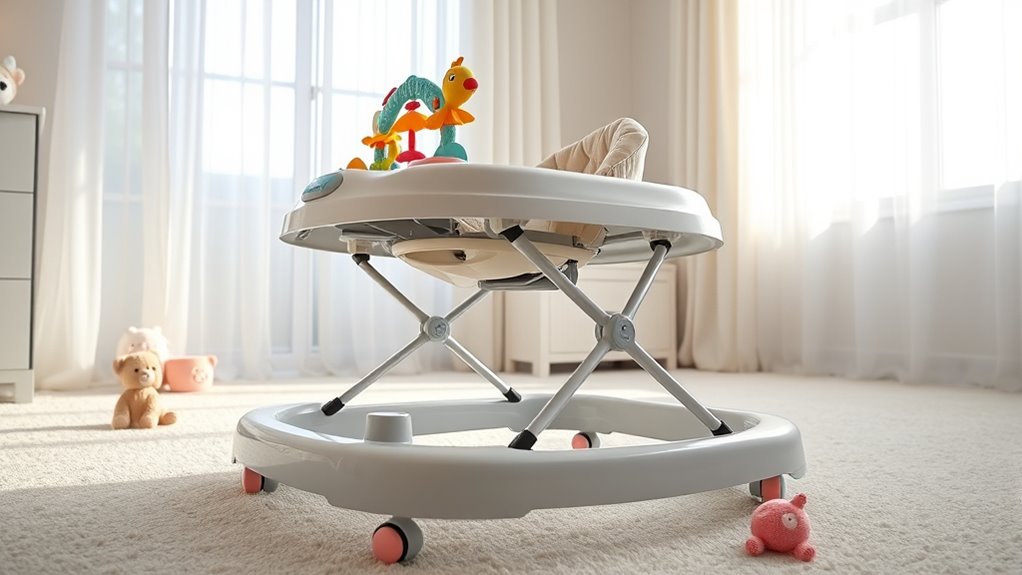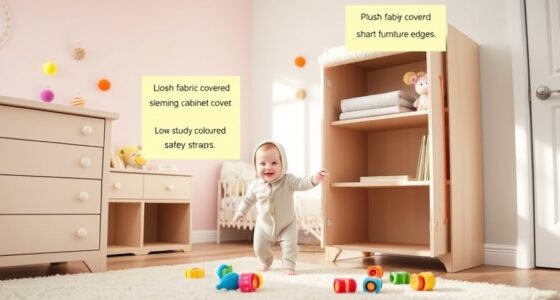Baby walkers are generally unsafe and can cause accidents, like falls, burns, or bumps into household hazards. They might also delay your child’s natural motor development by encouraging improper muscles and balance. Many experts advise against them, suggesting safer alternatives like tummy time and supervised floor play. If you want to understand the full risks and better options to support safe growth, there’s important information you won’t want to miss.
Key Takeaways
- Baby walkers pose significant safety risks, including tip-overs, household accidents, and access to hazards like hot surfaces and electrical outlets.
- They can delay motor development and proper muscle strength by encouraging improper walking techniques.
- Many health experts advise against using walkers, advocating for natural movement activities like tummy time instead.
- Walkers increase the risk of injuries, especially around stairs, sharp objects, and dangerous household zones.
- Supervised free play and floor activities effectively promote motor skills without the safety concerns of walkers.

Baby walkers may seem like helpful tools for encouraging mobility, but their safety is a serious concern that parents shouldn’t overlook. While they promise to help your little one practice walking, they can also introduce a range of household hazards that you might not immediately notice. Walkers can easily tip over or roll into dangerous areas, putting your baby at risk of falls, burns, or other injuries. Sharp corners, hot stoves, or uncovered electrical outlets become more accessible when your child is in a walker, increasing the chances of accidents. Additionally, the mobility these devices provide can lead your baby into unsafe spaces, making supervision a constant necessity.
Beyond immediate safety concerns, using a baby walker can have a significant developmental impact. Many experts believe that walkers can delay the natural progression of motor skills. When babies are placed in these devices, they often push with their toes rather than their entire foot, which can hinder proper muscle development needed for walking. This improper technique may lead to delays in standing and walking milestones. Moreover, since walkers often encourage a seated, tilted posture, they can interfere with your child’s sense of balance and coordination. Instead of exploring movement at their own pace, babies might become overly dependent on external support, slowing their overall motor development.
You should also consider that many healthcare professionals and child development experts advise against using baby walkers altogether. They argue that these devices can foster false confidence in a baby’s ability to walk, which might lead to risky behaviors or overestimating their skills. Instead, engaging your child in supervised tummy time, free play on the floor, and allowing them to explore their environment safely on their own is far more beneficial for their growth. These activities promote muscle strength, coordination, and confidence naturally, without the added risks associated with walkers. Furthermore, promoting natural movement helps develop core strength, which is essential for all future motor skills.
Frequently Asked Questions
Are There Any Safe Alternatives to Baby Walkers?
If you’re looking for safe alternatives to baby walkers, consider supervised tummy time and floor play. These activities promote child development and strengthen muscles naturally. Using play mats or activity centers with safety precautions guarantees your baby remains safe while exploring. Engaging with your child during these activities fosters development and keeps safety a priority. Always supervise your baby closely, avoiding equipment that could pose risks to their safety and development.
How Do Baby Walkers Impact Early Motor Development?
You might notice that baby walkers can influence early motor development by delaying motor skill milestones, as they often provide support that reduces the need for babies to practice crawling or standing. This can potentially lead to developmental delays if used excessively. To support healthy growth, focus on safe, supervised activities that encourage natural movement, helping your baby develop motor skills at the right pace without relying heavily on walkers.
Can Baby Walkers Prevent Falls at Home?
Imagine a shield guarding your little explorer as they navigate the jungle of indoor hazards. Baby walkers might seem like a safeguard, but they don’t prevent falls. Instead, they can create a false sense of security, making you less vigilant. Parental supervision remains your strongest armor, actively watching over your child’s steps and blocking dangers, ensuring they stay safe and secure in their world of discovery.
Are Certain Brands Safer Than Others?
You might wonder if some brands are safer than others. Generally, brand safety depends on thorough product testing and adherence to safety standards. Reputable brands conduct rigorous testing to ensure their baby walkers meet safety regulations, reducing risks. Always check for certifications and reviews before choosing a walker. Remember, even the safest brands can pose risks if used improperly, so supervision and proper setup are essential for your baby’s safety.
What Are the Legal Regulations on Baby Walker Sales?
You should know that legal restrictions on baby walker sales vary by country, often focusing on safety standards. Many places enforce regulations requiring manufacturers to meet specific safety criteria, like stability and brake mechanisms. These laws aim to reduce accidents and ensure product safety. To stay informed, check your local regulations, as compliance helps protect your baby and guarantees you’re buying from reputable sources that follow safety standards.
Conclusion
Ultimately, your child’s safety depends on your choices. For example, imagine a toddler who was in a walker and managed to reach an open staircase, resulting in a fall. This real risk highlights why many experts advise against walkers. While some parents see them as helpful, the potential dangers outweigh the benefits. By staying informed and choosing safer alternatives, you protect your little one from avoidable accidents and give them a safer start to exploring their world.










